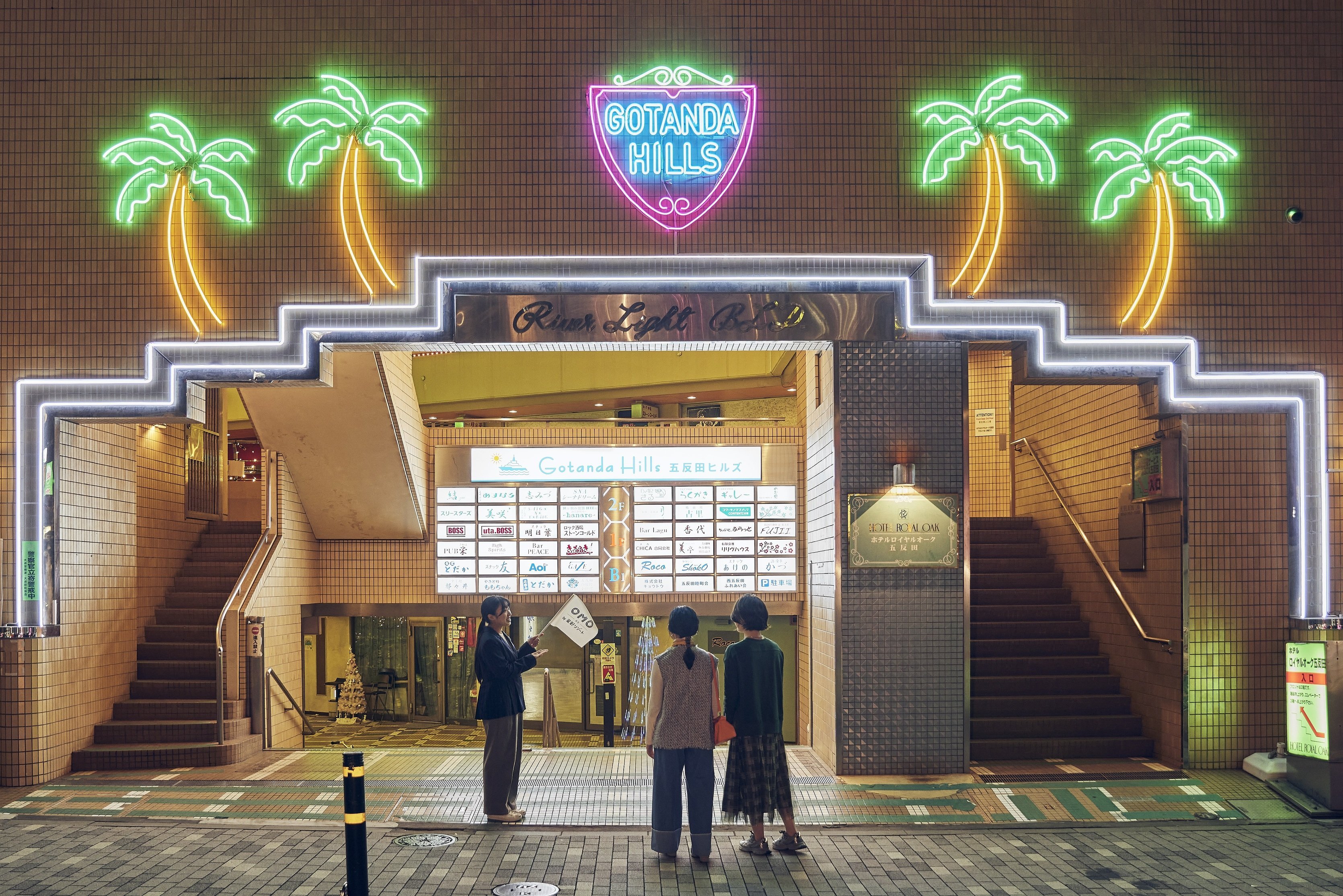
Neon palm trees lit up the facade above a dark entrance. Going down the steps, we entered an atrium lined with three storeys of small bars and restaurants. An attempt had been made to brighten up the nondescript interior by stringing fairy lights along the balconies.
Crates of beer and boxes of supplies were stacked by restaurant doors, while outside others were seats for customers to wait. I wondered where exactly we were having dinner.
It can be intimidating looking for somewhere to eat among Tokyo’s thousands of tiny restaurants. They’re hidden away in side streets or in multi-storey buildings such as Gotanda Hills, with minimal signage, no indication of the dishes served, and a closed front door. Once inside, you’ll find that the restaurant specialises in something that the chef has spent years perfecting, be it a Japanese dish or a foreign cuisine.

Our guide Shiho was waiting for us in the lobby, equipped with an OMO5 flag for us to follow. There was no danger of us getting lost however, as the maximum number of tour participants is three due to the small size of the bars and restaurants. Shiho led us through streets busy with the after-work crowd heading for drinks and dinner. Along the way, she pointed out a popular fried chicken kiosk and a park by the Meguro River where cherry trees blossom in spring. A few minutes later, we arrived at the Gotanda Hills building.

Dish after dish appeared in front of us, placed on the partition above the counter as we finished the previous one. Mr Enya trained in a traditional Japanese restaurant before opening his own establishment, and the food reflected this background. The first course was seaweed flavoured with vinegar and ginger, delicious but slippery, and a challenge to my chopstick technique. This was followed by butterfish sashimi resting on a bed of grated daikon, the delicate flavour of the fish contrasting with the sharper taste of the daikon.


In between courses, Shiho pointed out the framed artwork on the walls. At first sight, this looked liked cartoonish doodles accompanied by some writing, but they were actually autographs from celebrities who’d dined here.
The next course arrived in a beautiful little blue and white china pot. A cloud of steam spilled out as I lifted the lid but once this drifted away, I could see chawanmushi, a savoury egg custard.
Each spoonful was delicate and silky smooth, with morsels of greens, mushrooms, and chicken scattered throughout the custard.

With the meal over, it was time to move on to a bar. Shiho led us to a bright red door, the entrance to Boss bar. The interior was black apart from a glossy red counter that, like the restaurant, only had room for six people. Boss specialised in whisky, with rows of bottles lining the shelves behind the bar.
The young bartender, whose nails were lacquered the same red as the counter, asked what we’d like to drink, suggesting perhaps a whisky sour? As well as whisky, the bar also offers some beer, wine, and shochu, a Japanese spirit made from rice. I asked about non-alcoholic drinks and discovered the only option was iced tea, so that was what I ordered.
We sat with our drinks, watching trains passing by the window, coming and going from Gotanda station which has three commuter lines passing through it. The bartender told us that 80% of customers are "repeaters" or regulars and on busy nights she gives preference to them. A regular came in while we were there, straight from work judging by the suit, and it was obvious that he and the bartender knew each other well. Part of her job is to drink and chat with customers, so that they feel welcome.

After we left the bar, Shiho told us about other restaurants in Gotanda Hills. To dine at Todaka, patrons need to reserve three years in advance. It’s so popular that Todaka has two restaurants in Gotanda Hills and another one elsewhere in Gotanda.
Another restaurant, Tsuki, is renowned for its tuna sashimi served with olive oil and salt. By now, the building was humming with all the tiny restaurants and bars filled with diners and drinkers. Shiho was ready to give recommendations for those who wanted to continue the evening elsewhere in Gotanda, but I decided to return to the hotel.
As well as the bar-hopping tour, the hotel offers another service, Gotanda Gourmet Reception, featuring local restaurants that hotel staff have tried and can recommend. There are three options each day, with photos of the dishes to help guests decide where to dine. The staff explain the back story of each place and point out any interesting dishes or cooking techniques that the restaurant is known for.
When I was there, a pizzeria was one of the featured restaurants, with a video showing how they baked their pizzas. I learned that pizza is popular in Japan and it’s just one of many ethnic cuisines available in Gotanda. A large wall map in the reception area showed the variety of neighbourhood restaurants.
I hadn’t expected Gotanda to be a gourmet paradise, so a night out with a delicious Japanese meal was a pleasant surprise. Thanks to the local knowledge of OMO5 Gotanda’s staff and the relationships they’d developed with local businesses, I’d been to places that visitors normally wouldn’t find.
— OMO5 Gotanda by Hoshino Resorts hosted me for one night, including the bar-hopping tour.
— Denise Stephens












